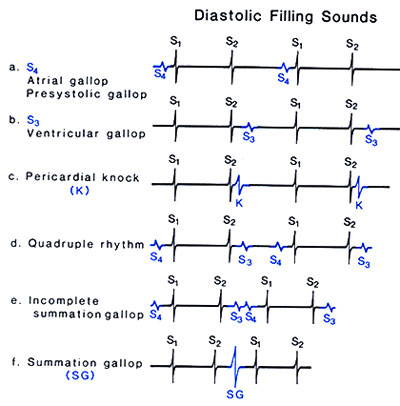
Figure 200n
A. The S4 occurs in presystole and
is frequently called an atrial or presystolic gallop.
B. The S3 occurs during the rapid phase of ventricular filling. It is
a nornal finding and is commonly heard in children and young adults,
disappearing with increasing age. When it is heard in the patient with
cardiac disease, it is called a pathologic S3 or ventricular gallop
and usually indicates ventricular dysfunction or AV valvular incompetence.
C. In constrictive pericarditis, a sound in early diastole, the pericardial
knock (K) is heard earlier and is louder and higher pitched than the
usual pathologic S3.
D. A quadruple rhythm results if both S4 and S3 are present.
E. At faster heart rates, the S3 and S4 occur in rapid succession and
may give the illusion of a middiastolic rumble.
F. When the heart rate is sufficiently fast, the two rapid phases of
ventricular filling reinforce each other, and a loud summation gallop
(SG) may appear; this sound may be louder than either the S3 or S4 alone.
(FromJ4 Shaver, et it Examination of
the Heart, Part IV,Auscultation, Dallas,American Heart Association,
1990,p27.